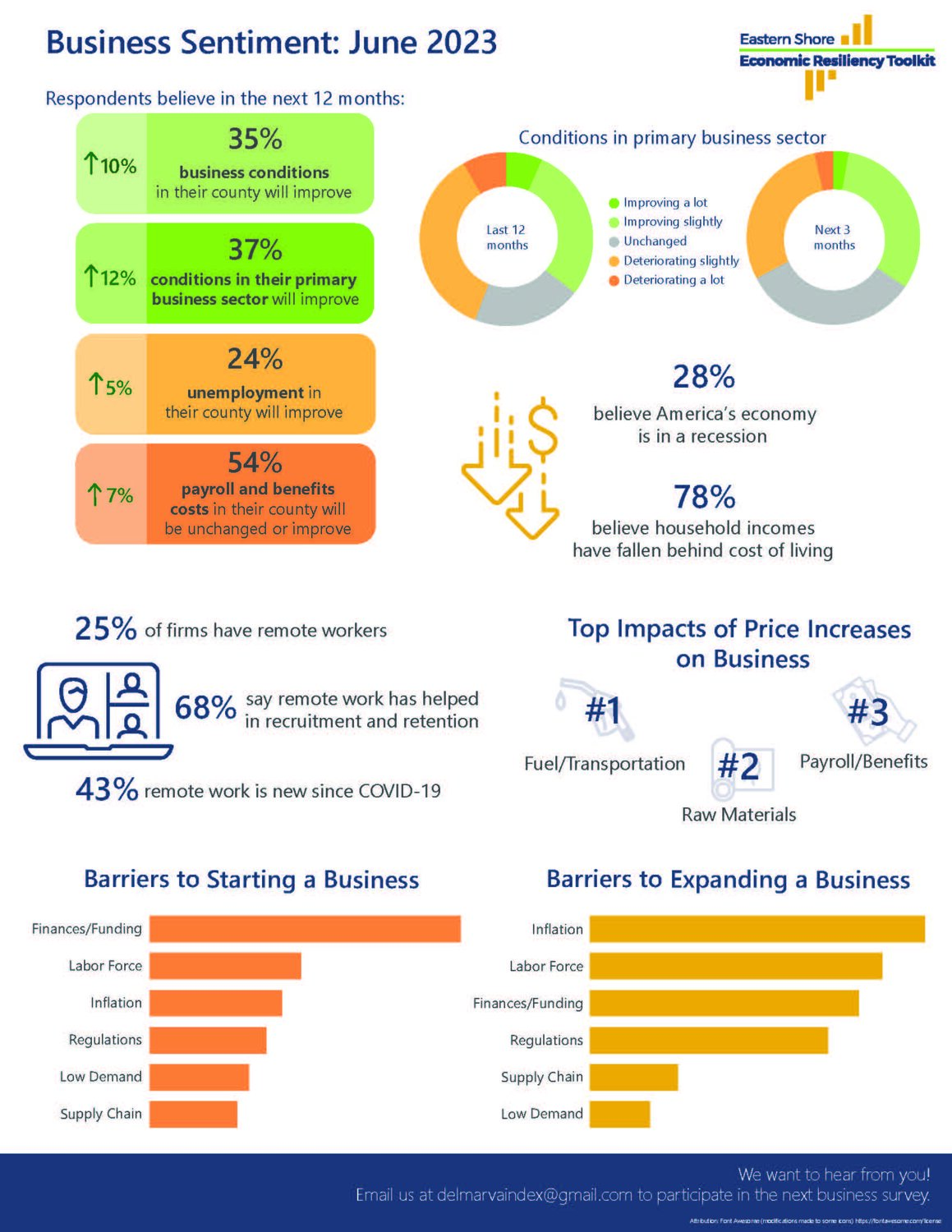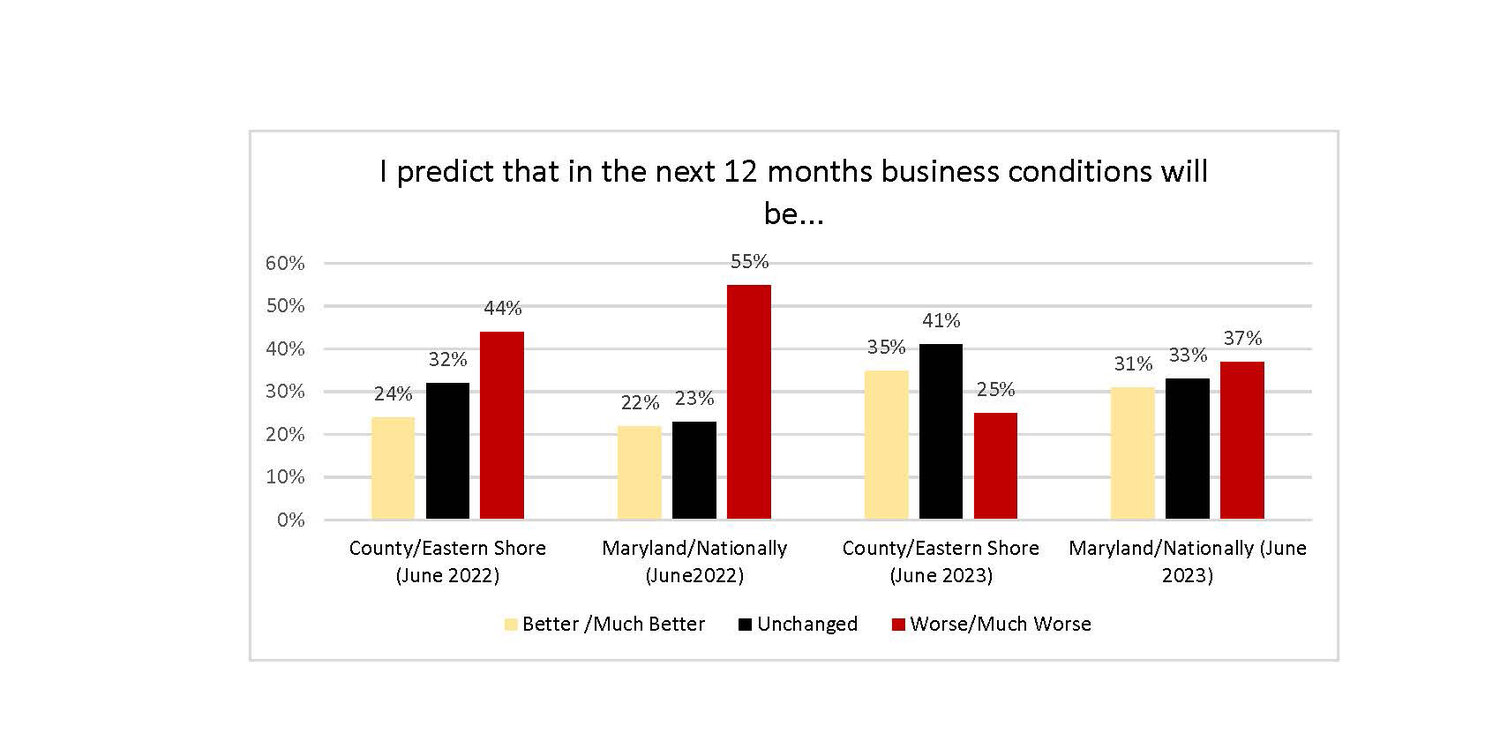Eastern Shore business survey shows remarkable optimism
Eastern Shore business owners and managers’ outlook on the economy are more optimistic than they were six months ago.
These trends are among the findings of the latest Eastern Shore …

You must be a member to read this story.
Join our family of readers for as little as $5 per month and support local, unbiased journalism.
Already a member? Log in to continue. Otherwise, follow the link below to join.
Please log in to continueNeed an account?
|
Eastern Shore business survey shows remarkable optimism
Eastern Shore business owners and managers’ outlook on the economy are more optimistic than they were six months ago.
These trends are among the findings of the latest Eastern Shore Business Sentiment Survey conducted through a partnership with Salisbury University’s Business Economic and Community Outreach Network (BEACON), SU’s Eastern Shore Regional GIS Cooperative (ESRGC), and many of the region’s economic and workforce development professionals.
The June 2023 results represent the fifth report released by BEACON. The first survey in the series was conducted in June 2021, with a follow-up in December 2021, and the most recent report in December 2022.
The survey included more than 50 questions, asking business leaders to weigh in on a range of topics, from general business concerns to conditions in their own industries. Respondents evaluated business conditions locally, regionally, in the state and nationwide for the coming year. They also shared views related to their specific industries and on issues from labor supply to regulations.
Results include:
- The 12-month outlook for business conditions in participants’ respective counties is significantly better than in June 2022. When asked to predict the business conditions in their counties and the Eastern Shore, 25 percent responded that they believe economic conditions will worsen, compared to 44 percent in June 2022. Those responding “Much Better/Better” increased by 11 points over 12 months. On a state and national level, almost 44 percent of participants believe economic conditions will be worse, compared to 63 percent in June 2022.
- Expectations for business conditions locally have improved significantly from December 2022 to June 2023. “Much Worse/Worse” responses fell from 38 percent in December to 25 percent in June. “Unchanged” responses increased to 41 percent in June 2023 after being 37 percent in December 2022, and “Much Better/Better” responses increased significantly to 55 percent from 25 percent in December 2022.
- Reflecting on their individual industry sectors, 44 percent of respondents believe business conditions “Deteriorated A Lot/Deteriorated Slightly” over the past 12 months. Respondents are optimistic about the short-term future, with 34 percent believing business conditions in their sector will “Improve Slightly/Improve A Lot” over the next three months. Respondents are optimistic about the long-term future, with 37 percent believing business conditions in their sector will “Improve Slightly/Improve A Lot” over the next 12 months.
- Respondents assessed inflation as the most significant barrier to expanding their sector, followed by labor force issues then finances and funding. The highest barrier to starting a new business in their specific sectors was labor force issues, followed by inflation and finances and funding.
- When asked which cost increase in the previous six months had the greatest impact on the respondents’ businesses, they noted that the increase in fuel and transportation had the highest impact. Close behind, the cost of raw materials and utilities were tied for the second largest impact on local firms.
- Respondents agreed payroll and benefit costs in the next 12 months would be worse or much worse in their county, region, state, and nation. However, “Worse/Much Worse” responses have decreased in the county, region, state and nation when compared to the December 2022 survey.
- Businesses generally are confident about their operation on a longer horizon. Over 79 percent believe their firm will be operating locally in the next five years, with just 6 percent predicting their business will not be operating locally five years from now.
- Even after the events of the COVID-19 pandemic, a majority of respondents’ firms do not have remote workers (75 percent). Of the firms with remote workers, the majority of the workers are in the county in which the business is located.
- Almost 78 percent believe household income for the average American has fallen behind the cost of living, while only 4 percent believe household incomes have surpassed the cost of living.
Respondents were increasingly optimistic in their expectations of the standard of living in the next five years. Across all areas, 39 percent believe it will remain the same, while 36 percent think it will rise, and 26 percent think it will fall. The number of respondents that said that the standard of living would fall on Maryland’s Eastern Shore over the next five years decreased by 16 points since the December 2022 survey.
Participants had mixed views on the current state of America’s economy, with overall thoughts improving. Participants generally believe the economy is “Stagnating” (36 percent), with 31 percent believing it is “Growing Rapidly/Growing Slowly.” Some 33 percent believe the economy is “In a Recession/Depression,” which is a significant decline from 47 percent six months ago.
A majority of responses came from company leadership, with business owners, presidents, CEOs and managing partners making up 68 percent of the participants. A total of 80 percent were from firms with fewer than 50 employees. Responses came from a wide variety of industries reflecting the economy of the region, with many respondents active in more than one industry.
Counties on the Eastern Shore will continue to conduct the survey every six months, with the data used to identify challenges facing the region, to assist in long-term planning and to guide the development of public policy.
The Eastern Shore Regional GIS Cooperative summarized the findings in infographics that can be found on the Eastern Shore Economic Recovery Project website, but economic developers also have access to an internal dashboard that enables them to mine the data for insight on specific issues.
Designed to gauge the opinions of the region’s business leaders, this survey is one of the tools that has grown out of the Eastern Shore Economic Recovery Project, a venture made possible by grants totaling $507,000 from the U.S. Economic Development Agency.
The Mid-Shore Regional Council and the Tri-County Council of the Lower Eastern Shore are recognized as Economic Development Districts by the EDA.
The data tools used in the project have been recognized with regional and national accolades including the Maryland Economic Development Association’s 2022 Economic Development Program Award, the 2022 International Economic Development Council Silver Award and the 2022 National Association of Development Organizations Aliceann Wohlbruck Impact Award.
In addition to the regional councils, partners in the project include ESRGC, BEACON, the Lower Shore Workforce Alliance, the Upper Shore Workforce Investment Board, and the Caroline, Cecil, Dorchester, Kent, Queen Anne’s, Talbot, Somerset, Wicomico and Worcester county economic development offices.
To access Eastern Shore Economic Recovery Project data, visit https://recovery.delmarvaindex.org. The complete Delmarva Index can be found at https://delmarvaindex.org.
Members and subscribers make this story possible.
You can help support non-partisan, community journalism.
Other items that may interest you









